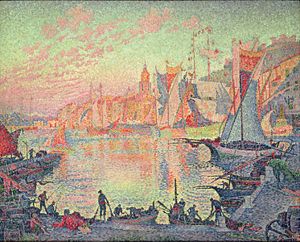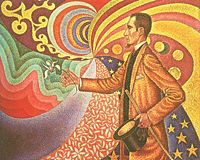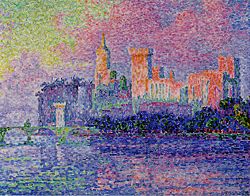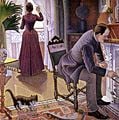Difference between revisions of "Paul Signac" - New World Encyclopedia
| Line 36: | Line 36: | ||
==Technique== | ==Technique== | ||
| − | Seurat was working with an early stage of pointillism called Divisionism, which employed strokes not quite dot like. | + | Seurat was working with an early stage of pointillism called Divisionism, which employed strokes not quite dot like. Under Seurat's influence Signac abandoned the short brushstrokes of [[impressionism]] in order to experiment with scientifically juxtaposed small dots of pure color, intended to combine and blend not on the canvas but in the viewer's eye - the defining feature of pointillism. The large canvas, ''Two Milliners'', 1885, was the first example of Divisionist technique (also called Neo-impressionist or Pointillist) applied to an outdoor subject. |
From his various ports of call, Signac brought back vibrant, colorful watercolors, sketched rapidly from nature. From these sketches, he would then paint large studio canvases that were carefully worked out in small, mosaic-like squares of color, quite different from the tiny, variegated dots previously used by Seurat. | From his various ports of call, Signac brought back vibrant, colorful watercolors, sketched rapidly from nature. From these sketches, he would then paint large studio canvases that were carefully worked out in small, mosaic-like squares of color, quite different from the tiny, variegated dots previously used by Seurat. | ||
| − | Signac himself experimented with various media. As well as oil paintings and [[watercolor painting|watercolors]], he made etchings, lithographs, and many pen-and-ink sketches composed of the small, luminous dots. | + | Signac himself experimented with various media. As well as oil paintings and [[watercolor painting|watercolors]], he made etchings, lithographs, and many pen-and-ink sketches composed of the small,luminous dots. |
| − | The neo-impressionists influenced the next generation: Signac inspired [[Henri Matisse]] and [[André Derain]] in particular, thus playing a decisive role in the evolution of [[Fauvism]]. | + | The neo-impressionists influenced the next generation: Signac inspired [[Henri Matisse]] and [[André Derain]] in particular, thus playing a decisive role in the evolution of [[Fauvism]]. |
| − | Watercolours form an important part of Signac's oeuvre and he produced a large quantity during his numerous visits to Collioure, Port-en-Bressin, La Rochelle, Marseille, Venice and Istanbul. The fluid medium allowed for | + | Watercolours form an important part of Signac's oeuvre and he produced a large quantity during his numerous visits to Collioure, Port-en-Bressin, La Rochelle, Marseille, Venice and Istanbul. The fluid medium allowed for greater expression than is found in his oil paintings, which are sometimes constrained by the limitations of color theory. Color being an important aspect of the artist's work, monochrome wash drawings such as ''Scène de marché'' are more rare. |
==Legacy== | ==Legacy== | ||
| Line 73: | Line 73: | ||
* ''Signac 1863-1935'', Réunion des Musées Nationaux, Paris 2001 ISBN 2-7118-4127-8 | * ''Signac 1863-1935'', Réunion des Musées Nationaux, Paris 2001 ISBN 2-7118-4127-8 | ||
* The New Encyclopædia Britannica, 1988, Volume 10, Micropædia, pg. 796 | * The New Encyclopædia Britannica, 1988, Volume 10, Micropædia, pg. 796 | ||
| − | * Francine Prose. "Not the Seurat We Think We Know. " Wall Street Journal New York, N.Y. | + | * Francine Prose. "Not the Seurat We Think We Know. " Wall Street Journal New York, N.Y. Nov. 29, 2007, Eastern edition: D.8. National Newspapers (5). ProQuest. Sno-Isle Libraries, Marysville, WA. 30 Nov. 2007 <http://www.proquest.com.access-proxy.sno-isle.org/></ref> |
===External links=== | ===External links=== | ||
{{commonscat}} | {{commonscat}} | ||
Revision as of 17:21, 3 December 2007
Paul Signac (November 11, 1863 - August 15, 1935) was a leading figure of French Neo-impressionism, the school of painters that followed the Impressionists. Along with Georges-Pierre Seurat, he helped develop the pointillist style. This movement inspired many other artists to develop the new genre, proving that art can be unlimited in its range when fueled by human curiousity and imagination.
Signac commentated on his contemporary Geroges Seurat's works of pointillism as "the most beautiful painter's drawings in existence,"[1] attesting to the beauty and pride Neo-Impressionists found in their newly emerging style of art.
Biography
Paul Victor Jules Signac was born in Paris on November 11, 1863 into the family of a well-to-do master harness-maker. The family lived above the store they owned but when Signac's father, Jules Jean-Baptist, died of tuberculosis in 1880, Signac was freed from having to run the family business.
Story has it that at age 16, the young Signac was thrown out of the fifth Impressionist exhibit by leading Post-Impresssionist Paul Gaugin for sketching a painting of Edgar Degas's that was on display.[2] The year 1880 proved to be a pivotal year for the young man who enrolled at the College Rollin in Montmarte to study mathematics, but soon dropped out to pursue a career as a painter.
He began a lifelong habit of escaping the city to paint off the coasts of France; his first painting, Haystack (1883) was painted at his maternal grandmother's house at Guise. Here he became enamored with sailing and sailboats. During his lifetime he would own thirty two sailing crafts in all.
In 1884 he met Claude Monet and Georges Seurat. At that time many of Signac's early works, including still-lifes and landscapes, were influenced by the impressionism of artists such as Monet. Signac, struck by the systematic working methods of Seurat and by his theory of colors, became his faithful supporter.
He left the capital each summer, to stay in the south of France in the village of Collioure or at St. Tropez, where he bought a house and invited his friends. In 1887, he met Vincent van Gogh in Paris. Not only did they become friends, but they often painted together. Both artists were exhibiting their paintings along with Georges Seurat by the end of 1887.[3]
The next year he made a short trip to Italy, visiting Genoa, Florence, and Naples.
Signac loved sailing and began to travel in 1892, sailing a small boat to almost all the ports of France, to Holland, and around the Mediterranean as far as Constantinople, basing his boat at St. Tropez, which was to ultimately become a favorite resort of modern artists.
In 1892 he married a distant cousin of Camille Pissaro's, Berthe Robles, who can be seen in his painting, The Red Stocking (1883). Witnesses at the wedding were artists Alexandre Lemonier, Maximilien Luce, Camille Pissarro and Georges Lecomte.
In November 1897, the Signacs moved to a new apartment in the "Castel Béranger", built by Hector Guimard. In December of the same year, they acquired a house in Saint-Tropez called "La Hune." There the painter had a vast studio constructed, which he inaugurated on August 16, 1898.
In September 1913, Signac rented a house at Antibes, where he settled with his mistress, Jeanne Selmersheim-Desgrange, who gave birth to their daughter Ginette on October 2, 1913. In the meantime Signac, who had left his wife, Berthe, bequeathed his properties to her; however, the two remained friends for the rest of his life. On April 6, 1927, Signac adopted Ginette, his previously illegitimate daughter.
Although, a self avowed anarchist like many of his contemporaries in France, including Camille Pissarro he was to become deeply opposed to Fascism towards the end of his life.
As president of the Société des Artistes Indépendants from 1908 until his death, Signac encouraged younger artists (he was the first to buy a painting by Matisse) by exhibiting the controversial works of the Fauves and the Cubists.
On August 15, 1935, at the age of seventy-two, Paul Signac died from septicemia. His body was cremated and he was buried at the Père-Lachaise cemetery in Paris.
Technique
Seurat was working with an early stage of pointillism called Divisionism, which employed strokes not quite dot like. Under Seurat's influence Signac abandoned the short brushstrokes of impressionism in order to experiment with scientifically juxtaposed small dots of pure color, intended to combine and blend not on the canvas but in the viewer's eye - the defining feature of pointillism. The large canvas, Two Milliners, 1885, was the first example of Divisionist technique (also called Neo-impressionist or Pointillist) applied to an outdoor subject.
From his various ports of call, Signac brought back vibrant, colorful watercolors, sketched rapidly from nature. From these sketches, he would then paint large studio canvases that were carefully worked out in small, mosaic-like squares of color, quite different from the tiny, variegated dots previously used by Seurat.
Signac himself experimented with various media. As well as oil paintings and watercolors, he made etchings, lithographs, and many pen-and-ink sketches composed of the small,luminous dots. The neo-impressionists influenced the next generation: Signac inspired Henri Matisse and André Derain in particular, thus playing a decisive role in the evolution of Fauvism.
Watercolours form an important part of Signac's oeuvre and he produced a large quantity during his numerous visits to Collioure, Port-en-Bressin, La Rochelle, Marseille, Venice and Istanbul. The fluid medium allowed for greater expression than is found in his oil paintings, which are sometimes constrained by the limitations of color theory. Color being an important aspect of the artist's work, monochrome wash drawings such as Scène de marché are more rare.
Legacy
Signac wrote several important works on the theory of art, among them From Eugene Delacroix to Neo-Impressionism, published in 1899; a monograph devoted to Johan Barthold Jongkind (1819-1891), published in 1927; several introductions to the catalogues of art exhibitions; and many other still unpublished writings. The quality and quantity of his work as an artist was matched in breadth by his interests as a writer.
In 2007, Paul Signac's "Cassis. Cap Canaille," from 1889 was sold in auction at Christie's for $14 million, setting a record for the artist.[4] Others of his works have sold in the several millions as while at similar auctions.
Gallery
Some of his well known paintings are: The Pine, Saint Tropez and Port St. Tropez.
Notes
- ↑ Francine Prose. "Not the Seurat We Think We Know. " Wall Street Journal [New York, N.Y.] 29 Nov. 2007, Eastern edition: D.8. National Newspapers (5). ProQuest. Sno-Isle Libraries, Marysville, WA. 30 Nov. 2007 <http://www.proquest.com.access-proxy.sno-isle.org/>
- ↑ Encyclopedia of World Biography Supplement, http://galenet.galegroup.com.access-proxy.sno-isle.org/servlet/BioRC
- ↑ http://Biography Resource Center, galenet.galegroup.com
- ↑ <"QUICK TAKES; Matisse record eclipsed at auction. " Los Angeles Times [Los Angeles, Calif.] 8 Nov. 2007,E.2. Los Angeles Times. ProQuest. Sno-Isle Libraries, Marysville, WA. 30 Nov. 2007 <http://www.proquest.com.access-proxy.sno-isle.org/>
ReferencesISBN links support NWE through referral fees
- "Paul Signac." Encyclopedia of World Biography Supplement, Vol. 23. Gale, 2003. Reproduced in Biography Resource Center. Farmington Hills, Mich.: Thomson Gale. 2007.
- Signac 1863-1935, Réunion des Musées Nationaux, Paris 2001 ISBN 2-7118-4127-8
- The New Encyclopædia Britannica, 1988, Volume 10, Micropædia, pg. 796
- Francine Prose. "Not the Seurat We Think We Know. " Wall Street Journal New York, N.Y. Nov. 29, 2007, Eastern edition: D.8. National Newspapers (5). ProQuest. Sno-Isle Libraries, Marysville, WA. 30 Nov. 2007 <http://www.proquest.com.access-proxy.sno-isle.org/></ref>
External links
- Official website
- "People's history": Paul Signac, a biography of the artist, with information about his anarchist politics
- Paul Signac biography Renoir Fine Art Inc.
- Paul Signac biography Olga's Gallery
Credits
New World Encyclopedia writers and editors rewrote and completed the Wikipedia article in accordance with New World Encyclopedia standards. This article abides by terms of the Creative Commons CC-by-sa 3.0 License (CC-by-sa), which may be used and disseminated with proper attribution. Credit is due under the terms of this license that can reference both the New World Encyclopedia contributors and the selfless volunteer contributors of the Wikimedia Foundation. To cite this article click here for a list of acceptable citing formats.The history of earlier contributions by wikipedians is accessible to researchers here:
The history of this article since it was imported to New World Encyclopedia:
Note: Some restrictions may apply to use of individual images which are separately licensed.












